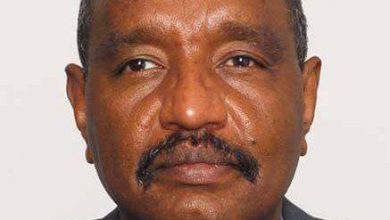Opinion
Sudan’s civil war fueled by secret arms shipments from UAE and Iran
Despite denials, weapons inspection and confidential assessments reveal that both the Rapid Support Forces and Sudanese military are supported from abroad

By Katharine Houreld and Hafiz Haroun
Sudan’s devastating civil war is being fueled in part by weapons secretly supplied to both sides by foreign countries, including munitions and drones from the United Arab Emirates and Iran, according to confidential assessments, a State Department-funded report, and evidence collected from captured weapons in Sudan.
Sudanese military officials in the city of Omdurman recently allowed Washington Post journalists to inspect a drone that the officials said had been captured from the rival paramilitary Rapid Support Forces along with munitions for the drone. The officials provided photos of the crates they had captured, including one with labeling that indicated the munitions had been manufactured in Serbia and sent to the UAE Armed Forces Joint Logistics Command.
This apparent evidence of UAE involvement aligns with the findings of the Sudan Conflict Observatory, a group funded by the U.S. State Department that tracked Emirati flights. In an assessment shared exclusively with The Post ahead of publication on Tuesday, the group said it tracked 32 flights between June 2023 and May 2024 and concluded with “near certainty” that they were weapons transfers from the UAE to the RSF.
The RSF has denied receiving military support from the UAE, and UAE diplomats strenuously rejected such allegations when they were raised by United Nations officials earlier this year. “The UAE is not providing any support or supplies to the Rapid Support Forces (RSF) or any other warring parties,” the Emirati Ministry of Foreign Affairs said in a statement to The Post.
Since the end of last year, Sudan’s military has also been using foreign-supplied armed drones, in particular those secretly provided by Iran, according to the Observatory’s report. The group tracked seven flights between Iran and Sudan from December until July. Four of the flights were believed to be military because they returned to an Iranian air force apron at a Tehran airport, the report said. The other three turned off their trackers as they landed in Iran, but this suspicious behavior suggested they carried military cargo, the report said.
While Sudanese military officials have publicly denied receiving drones from Iran, a Sudanese security official confirmed that they had. Iranian officials did not respond to requests for comment.
While arms shipments from the UAE and Iran to Sudan’s warring parties have been previously disclosed, including in a New York Times account of Emirati support for the RSF using an airfield in neighboring Chad, some details about the frequency, pattern, and nature of flights from the UAE and Iran have not been previously reported.
Sudan’s civil war erupted in April 2023 after months of escalating tensions between the military and the RSF, which shared power in ruling the country. Since then, about a fifth of the population has been displaced, and famine looms.
U.S.-sponsored peace talks have faltered, while several other countries in the region have stoked the conflict by supplying military support, raising the prospect that the war could spread beyond Sudan’s borders and destabilize its neighbors.
A destroyed tank lies on a street in Omdurman on June 15. The military clawed back control of Omdurman a couple of months after planes began arriving from Iran in December.
More than half the population of Sudan needs food aid. “Having a country that is sinking into not just violence and instability but potentially a failed state is something that creates enormous risks … for regional stability,” U.S. Special Envoy to Sudan Tom Perriello said. “Every country in the region stands to lose far more by letting the country collapse than they might gain from pursuing narrow interests.”
Sudan’s western Darfur region is now under a United Nations arms embargo, but not the country as a whole. The UAE and Iran, as well as Egypt, Saudi Arabia, Turkey, and Russia, have followed developments with keen interest because of Sudan’s strategic location on the Red Sea, which sees about 12 percent of world shipping. “The Horn of Africa has become an arena for competing interests from the Gulf, who are financing and weaponizing local proxies,” said Alexander Rondos, a senior adviser with the Africa Center at the U.S. Institute of Peace. “Whoever controls Sudan, controls the Red Sea.”
The UAE’s involvement in Sudan is motivated by concerns over the Red Sea shipping lanes, crucial for trade at Emirati ports, and over the potential return of Islamists who long flourished in Sudan under former president Omar al-Bashir, diplomats and regional analysts say. The UAE also has extensive interests in Sudan’s gold and agriculture sectors, and longtime ties to RSF commander Gen. Mohamed Hamdan Dagalo, universally known as Hemedti.
The UAE is an important U.S. ally, valued for its military and diplomatic cooperation in the Middle East. Last month, President Joe Biden designated the UAE as “a major defense partner of the United States.” He did not mention Emirati support for Sudanese fighters. Two Western diplomats, who spoke on the condition of anonymity because they were not authorized to speak to the press, described the Emirati denials of arming the RSF as “ridiculous” and “comical.”
In tracking the Emirati flights, the Sudan Conflict Observatory found that they routinely landed at the Amdjerass airport in northeastern Chad, close to its long, porous border with Sudan. The Emiratis say the Amdjerass base is a hospital for wounded civilians, although it is several hours’ drive from the camps for Sudanese refugees.
Sudan’s commander in chief, Abdel Fattah al-Burhan, said in an interview that he blamed both Chad and the UAE for the ongoing conflict. “We want to end this war, but we need the Emirates to stop supporting the RSF,” Burhan said.
Sudan’s military has received substantially less outside support than the RSF, diplomats say.
The drone that military officials showed to Post journalists was captured from the RSF in March, they said, after a month-long battle at the Sudan Broadcasting Corporation building in Omdurman, along with the console and bomblets. Military technicians said the drone had been assembled from commercially available components.
The drone carried 120-mm airdrop munitions. The officials said the military had captured nearly 300 crates of them and allowed Post journalists to examine some of the munitions, which had been repackaged. While the munitions did not have any markings indicating where they were made, other information on the munitions matched that shown in photos of a captured crate, which also had a label saying the munitions were manufactured by Serbia’s state-owned Jugoimport-SDPR JP and supplied to the UAE Armed Forces Joint Logistics Command.
Jonah Leff, the executive director of U.K.-based Conflict Armament Research, reviewed photos of the crate and said the labeling is consistent with markings applied by Serbian manufacturers. Jugoimport-SDPR JP did not respond to requests for comment. Jeremy Binnie, the Middle East defense specialist for Janes, said pictures of so-called suicide drones used in Sudan seemed to match an image of a drone displayed by the UAE in Abu Dhabi. Another type of drone used in Sudan, multicopters that drop bomblets, has been seen in other conflicts where the UAE was involved, including in Yemen and Ethiopia, he said.
Sudan’s military has received substantially less outside support than the RSF, diplomats say. Support from the military’s long-standing ally, Egypt, cooled after the UAE promised to invest $35 billion in Egypt, Sudanese officials said. So, Sudan’s military contacted Iran and Russia.
Military leaders normalized relations with Tehran in October, eight years after Sudan broke off relations. Secret flights from Iran to Sudan started arriving in December, using a plane previously identified by the U.S. government as delivering arms to Syrian fighters linked to Iran, the Observatory said. The most recent flight was on July 23.
Since flights began in December 2023, there has been an increase in Iranian weapons identified on the battlefield. These include an Iranian-made Mohajer-6 drone shot down in Khartoum, a Mohajer-6 drone and ground control station, a single-payload drone similar to Iranian variants used in Yemen, and significant amounts of Iranian artillery guns and munitions.
Lieutenant General Yasser al-Atta, Sudan’s Assistant Commander in Chief, denied the military had recently received Iranian drones. But another security official confirmed the receipt of the drones. The official, who spoke on the condition of anonymity because he was not authorized to speak to the press, said Iran had sought to build a naval base on the Red Sea in return for the drones and other military help, but that the Sudanese military had paid for the drones outright.
Sudan’s military has also been bolstered by fighters from former rebel forces. Members of the militia of Minni Arko Minnawi were seen performing exercises in the back of a pickup truck in Gedaref, Sudan, on June 24. Meanwhile, members of the Sudanese army were observed passing by busy streets as the population prepared to celebrate Eid al-Adha in Omdurman on June 15. Despite this, the military continues to receive less external support than the RSF, diplomats confirm.
The flights operated by the Iranian company Fars Air Qeshm began at Iran’s Mehrabad airport and continued to Bandar Abbas in southern Iran before heading to Port Sudan, according to the report. Both Mehrabad and Bandar Abbas are key bases for Iran’s Islamic Revolutionary Guard Corps. Mehrabad hosts the 1st Tactical Airbase, home to Iranian Aircraft Industries, while Bandar Abbas is a base for an Iranian drone fleet.
The report highlighted that since these flights began in December 2023, there has been an increase in Iranian weapons identified on the battlefield. This includes the Mohajer-6 drone shot down in Khartoum, and similar variants used in other conflicts like Yemen. Significant amounts of Iranian artillery guns and munitions were also discovered.
In response to inquiries, Lieutenant General Yasser al-Atta denied that the military had received any recent drone deliveries from Iran. However, another security official, speaking under anonymity, confirmed that the drones had indeed been received, stating that Iran had initially sought to establish a naval base on the Red Sea in exchange for military support, though the military opted to pay for the drones directly.
The Iranian flights, operated by Fars Air Qeshm, began at Iran’s Mehrabad airport, continuing through Bandar Abbas before reaching Port Sudan. These two airports are crucial military hubs for the Islamic Revolutionary Guard Corps (IRGC). Mehrabad hosts the 1st Tactical Airbase, an essential facility for Iranian Aircraft Industries, while Bandar Abbas serves as a key base for Iran’s drone fleet.
Since these secret flights began in December 2023, there has been a noticeable increase in Iranian weapons on the Sudanese battlefield, including Mohajer-6 drones, artillery guns, and munitions. The report notes that an Iranian-made Mohajer-6 drone was shot down in Khartoum, and similar single-payload drones, used in Yemen, were also found in Sudanese battle zones.
Despite the denials of Sudanese officials, a security source, speaking anonymously, confirmed that Sudan had indeed received drones from Iran. Initially, Iran had sought to exchange these military supplies for the opportunity to build a naval base on the Red Sea, but the Sudanese military opted to purchase the drones outright. This arrangement emphasizes the deepening military ties between Sudan and Iran amidst a conflict that has drawn multiple international actors into its fold.
Adding to the complexity, Sudan’s military has been bolstered by fighters from former rebel forces. This includes fighters from the militia led by Minni Arko Minnawi, which were seen performing military exercises in the city of Gedaref in June 2024. At the same time, the Sudanese army was seen patrolling busy streets in Omdurman, preparing for the Eid al-Adha celebrations. Despite this, the military continues to receive significantly less external support compared to the RSF.
The report concludes by emphasizing how the ongoing support from foreign actors, whether through covert arms shipments or military aid, has prolonged and intensified the conflict. This foreign interference has raised concerns about the broader regional impact of Sudan’s war, especially given the country’s strategic importance on the Red Sea. The involvement of major powers like the UAE and Iran, alongside other regional players such as Egypt, Saudi Arabia, and Russia, underscores how the civil war in Sudan is not just a local or national issue, but part of a larger geopolitical struggle for influence in Africa and control over critical maritime routes.
The conflict, which began as a power struggle between Sudan’s military and the RSF, has now drawn in international interests, complicating peace efforts and further destabilizing the region. Meanwhile, millions of Sudanese civilians continue to suffer, with widespread displacement and a looming famine adding to the growing humanitarian crisis.
As the civil war in Sudan drags on, the humanitarian situation has reached catastrophic levels. More than 5 million people have been displaced, and at least half of the population now depends on food aid. The war has destroyed critical infrastructure, particularly in urban areas like Khartoum and Omdurman, where homes, hospitals, and schools have been reduced to rubble.
The international community has struggled to mediate peace talks, with U.S.-sponsored negotiations making little progress. Several countries have provided conflicting support to the warring factions, complicating efforts to reach a ceasefire. Nations like Egypt and Saudi Arabia, while concerned about the potential spillover effects of the war, have been hesitant to intervene directly, wary of becoming entangled in the broader conflict.
The involvement of regional powers such as the UAE and Iran has significantly intensified the conflict. The UAE’s interest in securing the Red Sea shipping lanes and protecting its investments in Sudan’s gold and agriculture sectors has led it to support the RSF, despite diplomatic denials. At the same time, Iran’s covert provision of armed drones to Sudan’s military has deepened its influence in the region. Both nations have been accused of fueling the violence in pursuit of their own strategic interests.
International sanctions and arms embargoes have been proposed to curb the influx of foreign military support, but enforcing such measures has proven difficult. The porous borders with Chad and other neighboring countries provide easy access for arms traffickers and allow the warring factions to resupply with little interference. This has led to fears that the conflict could destabilize not just Sudan, but also the entire Horn of Africa and beyond.
The report also underscores the dangers of Sudan becoming a failed state. The lack of central control, coupled with the foreign interventions, risks turning the country into a battleground for proxy wars. With the growing involvement of outside powers, there are concerns that Sudan could follow the trajectory of other conflict-ridden states in the region, such as Yemen and Libya, where foreign actors have prolonged civil wars for their own gain.
Sudan’s strategic location on the Red Sea makes it a vital interest for many international players. Control of this region would give any power significant influence over one of the world’s most critical maritime routes. As a result, countries from the Middle East, as well as global powers like Russia, are closely monitoring developments in Sudan, with some providing material support to different factions.
Despite these grim developments, there are calls from the international community to reinvigorate peace efforts. Humanitarian organizations have urged for an immediate ceasefire to allow aid to reach those in desperate need, particularly in regions like Darfur, which has been severely affected by both fighting and famine. Without swift intervention, the human toll is expected to rise, and the political and economic consequences of the war could reverberate far beyond Sudan’s borders.
In conclusion, the Sudanese civil war has escalated into a conflict driven by both internal power struggles and external geopolitical interests. With the involvement of countries like the UAE and Iran, the war has taken on an international dimension, complicating peace efforts and exacerbating the humanitarian crisis. If the international community fails to find a solution soon, the risk of a prolonged conflict with devastating regional consequences remains high.
As the war continues to devastate Sudan, there is growing concern that the conflict could spiral even further out of control, engulfing neighboring countries and drawing more international actors into the fray. The United Nations and various humanitarian organizations have warned that the longer the conflict persists, the harder it will be to restore peace and stability to the region. The influx of weapons and military support from foreign powers is only adding fuel to the fire, making it increasingly difficult for any diplomatic solution to gain traction.
The United Nations has already imposed an arms embargo on Sudan’s western Darfur region, but calls for a broader international embargo on arms flowing into Sudan have gained momentum. Such measures could limit the military capabilities of both the Sudanese military and the RSF, but enforcement remains a significant challenge given the smuggling routes through neighboring countries like Chad and Libya, as well as the continued covert flights from countries like Iran and the UAE.
Meanwhile, Sudan’s humanitarian crisis continues to deepen. Reports indicate that vast numbers of civilians are trapped in conflict zones with little access to food, water, or medical supplies. The country’s health system, already strained by years of neglect, has collapsed in many areas, with hospitals destroyed and medical personnel fleeing the violence. Famine looms over large swaths of the country, particularly in Darfur and the southern regions, where food shortages are compounded by displacement and ongoing violence.
The international community faces a difficult balancing act. On the one hand, there are calls to pressure foreign actors like the UAE and Iran to cease their military support for the warring factions, as this would potentially reduce the intensity of the fighting. On the other hand, regional powers are deeply invested in Sudan’s outcome, not only for its resources but also for its strategic position. With the Red Sea as a critical maritime route, whoever controls Sudan holds sway over a significant portion of global shipping lanes, making it an attractive prize for outside interests.
Additionally, the risk of the war spreading beyond Sudan’s borders is a growing concern. Neighboring countries like South Sudan, Chad, and the Central African Republic are already grappling with their own internal conflicts, and the instability in Sudan could exacerbate these issues. Refugee flows have increased significantly, placing pressure on neighboring countries to absorb displaced populations while struggling with limited resources themselves.
Efforts by the African Union (AU) and the Intergovernmental Authority on Development (IGAD) to broker peace have been largely unsuccessful, as the conflicting interests of international powers have hindered unified action. The AU has called for an immediate ceasefire and the resumption of peace talks, but both the military and the RSF remain entrenched in their positions, with neither side willing to back down without securing significant concessions.
The longer the conflict continues, the greater the risk that Sudan could become a failed state, with multiple factions vying for control and foreign powers further entrenching their influence. This scenario would not only prolong the suffering of millions of Sudanese civilians but also destabilize the entire region, potentially turning Sudan into a new front for international proxy wars.
In the midst of all this, the Sudanese people are bearing the brunt of the conflict. Civilians are caught in the crossfire, with many forced to flee their homes in search of safety, while others remain trapped in besieged cities with little hope of relief. As the war rages on, the prospects for peace seem increasingly distant, and the international community is faced with the urgent task of finding a way to halt the violence and address the growing humanitarian disaster before it spirals even further out of control.
The Sudanese civil war, now heavily influenced by foreign military support and geopolitical interests, threatens to become a prolonged and intractable conflict unless decisive action is taken. Without a coordinated international effort to cut off the flow of arms and broker a meaningful ceasefire, the war could drag on for years, with devastating consequences for both Sudan and the wider region.



